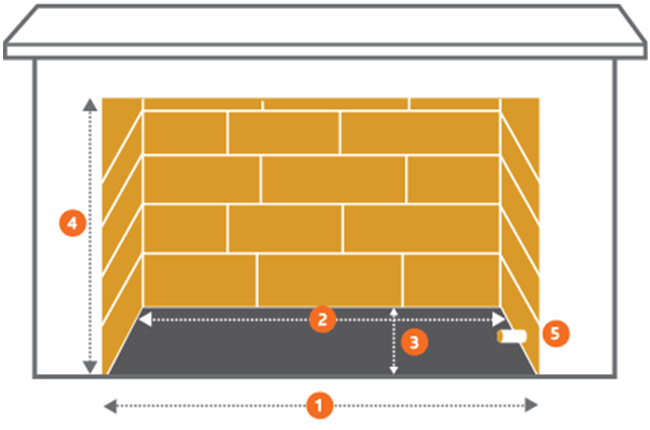How to Choose Your New Gas Logs1
Please read disclaimer
Use this simple guide to give you a good idea about making the right choice for your home fireplace. Here are the key measurement and venting choices to consider when selecting your new Gas Fire Logs.
STEP 1: DETERMINE VENTING OPTIONS
All Gas Log Sets fall into two basic categories, Vented and Vent Free. Each venting option has its advantages. If you are choosing gas fire products for an existing fireplace, check to see which venting system is currently in place. If you are choosing fireplace products for a new fireplace, consider the differences between these two options.
VENTED, OR VENT-FREE
Vented
- More realistic and natural looking flame than vent free
- Must be installed in a fully functioning wood burning fireplace
- Majority of heat is lost as it goes up the chimney (heat output is like burning wood)
- Produces some soot when flame touches log
Vent-Free
- Delivers more heat inside your home than vented gas fires
- Must be installed in a fireplace approved for a vent-free log set
- Installation is subject to state & local codes (some areas do not allow vent-free)
STEP 2: DETERMINE THE SIZE OF YOUR GAS LOGS
- To get your perfect design and feel, it’s important to determine the size of log set.
- This simple measuring process will help you determine the right size. It’s a good idea to contact Log Lighter Sales.
- Have a note pad handy and follow the diagram and steps below.
Follow these simple steps:

- Measure the front width of your fireplace
- Measure the width at the back of your fireplace
- Measure the depth from the front to the back of your fireplace
- Measure the height from the top to bottom of the front your fireplace
- Measure the height from the top to bottom of the back your fireplace
STEP 3: HOW DO YOU WANT TO START AND CONTROL YOUR GAS FIRE?
Light with Matches
This option is for natural gas only. There is no pilot, only the logs and burner. You control your flame height using your key valve which is normally located outside the fireplace either in the wall or floor.
Safety Pilot
This system has a safety pilot that is manually lighted and stays lit all the time. (much like your hater heater) You can turn the burner on and off manually by reaching inside your fireplace and turning the control knob. You cannot operate this type of system with a remote-control unit.
Remote Control
Remote Control systems include a remote pilot valve assembly. Depending on the remote option you select, you will have the ability to control certain functions of the log set from a remote control. Remote controlled options include basic on/off control as well as variable flame height control.
How to Choose Your New Gas Logs
Please read disclaimer
Use this simple guide to give you a good idea about making the right choice for your home fireplace. Here are the key measurement and venting choices to consider when selecting your new Gas Fire Logs.
STEP 1: DETERMINE VENTING OPTIONS
All Gas Log Sets fall into two basic categories, Vented and Vent Free. Each venting option has its advantages. If you are choosing gas fire products for an existing fireplace, check to see which venting system is currently in place. If you are choosing fireplace products for a new fireplace, consider the differences between these two options.
VENTED, OR VENT-FREE
Vented
- More realistic and natural looking flame than vent free
- Must be installed in a fully functioning wood burning fireplace
- Majority of heat is lost as it goes up the chimney (heat output is like burning wood)
- Produces some soot when flame touches log
Vent-Free
- Delivers more heat inside your home than vented gas fires
- Must be installed in a fireplace approved for a vent-free log set
- Installation is subject to state & local codes (some areas do not allow vent-free)
STEP 2: DETERMINE THE SIZE OF YOUR GAS LOGS
- To get your perfect design and feel, it’s important to determine the size of log set.
- This simple measuring process will help you determine the right size. It’s a good idea to contact Log Lighter Sales.
- Have a note pad handy and follow the diagram and steps below.
Follow these simple steps:

- Measure the front width of your fireplace
- Measure the width at the back of your fireplace
- Measure the depth from the front to the back of your fireplace
- Measure the height from the top to bottom of the front your fireplace
- Measure the height from the top to bottom of the back your fireplace
STEP 3: HOW DO YOU WANT TO START AND CONTROL YOUR GAS FIRE?
Light with Matches
This option is for natural gas only. There is no pilot, only the logs and burner. You control your flame height using your key valve which is normally located outside the fireplace either in the wall or floor.
Safety Pilot
This system has a safety pilot that is manually lighted and stays lit all the time. (much like your hater heater) You can turn the burner on and off manually by reaching inside your fireplace and turning the control knob. You cannot operate this type of system with a remote-control unit.
Remote Control
Remote Control systems include a remote pilot valve assembly. Depending on the remote option you select, you will have the ability to control certain functions of the log set from a remote control. Remote controlled options include basic on/off control as well as variable flame height control.

